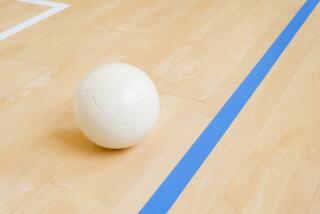Fallout on the Court
- Share via
Jeffrey Das can count on one hand the number of players he believes have a chance to win the Southern Section singles championship this year.
“Besides me, there’s really only three or four other guys out there,” the Fullerton Troy High senior said.
“There’s Garrett Snyder, Kevin McQuaid, Jack Li. Maybe Kaes Van’t Hof ... and that’s pretty much it.”
By season’s end, the field of contenders could turn out to be deeper, but probably not much, according to coaches and players who say Das’ checklist is an accurate reflection of elite boys’ tennis players after the sport was hit hard by graduation and decisions by some not to compete for their high schools.
“It’s not even close to what it was last year,” said Coach Mike Margolin, in his fifth at Beverly Hills. “This is the biggest drop-off we’ve had since I started coaching.”
Most of the players who set the standards in high school tennis the last few seasons have moved on.
Last year’s Southern Section champion, Cerritos Whitney’s Chris Surapol, is at UCLA. So is Aaron Yovan, a former Irvine University standout and two-time Southern Section semifinalist.
Doug Stewart, the 2001 Southern Section champion and the runner-up last year while at Malibu, is at Virginia. So is Rylan Rizza, a Southern Section quarterfinalist as a senior at Rolling Hills Estates Peninsula.
Former San Bernardino San Gorgonio standout Malcolm Scatliffe, a Southern Section semifinalist the last two seasons, earned a scholarship to Penn State. Patrick Buchanan, the 2001 Southern Section runner-up from Anaheim Servite, is at Notre Dame.
“Tennis-wise, it was pretty competitive,” said Irvine University’s Li, who will play at Harvard next season. “There’s still good No. 1s out there, but we lost a lot of special players.”
Of the 16 players who advanced to the fourth round of the Southern Section individual tournament last spring, 11 graduated. Among those were six of the eight quarterfinalists. Another quarterfinalist, Glendale Hoover junior Dylan Kim, decided to compete on lower-level pro tours instead of return for his senior season.
“It’s unbelievable the level that was there,” Margolin said. “The juniors and seniors in the last three, four years were just really impressive.”
Das, who is 21-0 in sets, is ranked No. 5 in the U.S. Tennis Assn. boys’ 18 division in Southern California. Snyder is the No. 1 singles player at Corona del Mar after winning the last two Southern Section doubles titles with different partners. Li won the USTA Southern California boys’ 16 sectional title in 2001 and may be the hottest player after winning boys’ 18 division titles at the South Bay, San Diego and Long Beach junior tournaments this year.
A few seniors who may figure in later rounds of the Ojai interscholastic division tournament next week and the Southern Section tournament next month include Arcadia’s Mark Contreras, Brentwood’s Eric McKean, Fairmont Prep’s Christian Hand and Santa Ana Foothill’s Kyle Roybal. Among juniors, Santa Ana Mater Dei’s Van’t Hof and Anaheim Servite’s Jonathan Sanchez are most ready to challenge.
The opportunity also is there for younger players to step in, with sophomores Gary Sacks of Calabasas and Carsten Ball of Corona del Mar the most likely candidates.
Sacks, No. 2 in the USTA boys’ 16 Southern California rankings, is unbeaten this season and seeded fourth in the boys’ 16 division at this week’s Easter Bowl/USTA Super National Spring Championships in Palm Springs. Ball is 24-2 in sets, losing only to Li and Van’t Hof.
“Last year, there were stars all over,” said Irvine University Coach John Kessler, who had several on a team that won its third consecutive section title but would lose four of his top five players to graduation. “This year, I think there’s a lot of good players who are all pretty even. There’s a lot of parity.”
Among the Times’ top 10, only No. 1 Corona del Mar has maintained its position all season.
“It’s a situation where Peninsula’s good, not great. We’re good, but not great. Woodbridge is good, not great,” Kessler said. “There may not be those elite teams out there.”
The lack of standout players and prevailing competitive equity has made the contributions of doubles players at the bottom of a team’s lineup more critical.
“Coaches and other people must recognize that this is team tennis,” Harvard-Westlake Coach Chris Simpson said. “The No. 2 and 3 doubles can be just as important as No. 1 singles.”
More to Read
Get our high school sports newsletter
Prep Rally is devoted to the SoCal high school sports experience, bringing you scores, stories and a behind-the-scenes look at what makes prep sports so popular.
You may occasionally receive promotional content from the Los Angeles Times.






